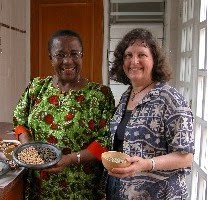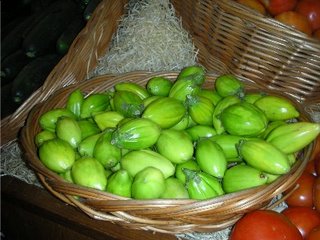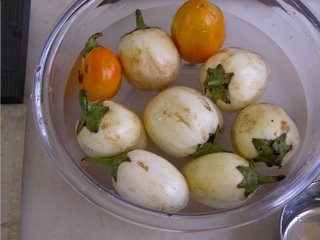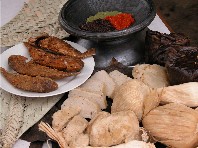Flair Cooks for Obamas in Ghana
 I telephoned my colleague Barbara Baeta of Flair Catering in Ghana (and my collaborator on our upcoming Ghanaian cookbook, the recipes of which are appearing in development on Betumiblog regularly) to find out if she could help me discover what the Obama family was served during their stay in Accra in July. It turns out the one State meal catered for them was breakfast, and her own Flair Catering was selected to provide that meal (for 600 people)! She's sending me the menu tomorrow (Thursday), so check back to find out what was served. Barbara was quick to point out that she knows what Flair served, but not what the Obamas themselves actually ate.
I telephoned my colleague Barbara Baeta of Flair Catering in Ghana (and my collaborator on our upcoming Ghanaian cookbook, the recipes of which are appearing in development on Betumiblog regularly) to find out if she could help me discover what the Obama family was served during their stay in Accra in July. It turns out the one State meal catered for them was breakfast, and her own Flair Catering was selected to provide that meal (for 600 people)! She's sending me the menu tomorrow (Thursday), so check back to find out what was served. Barbara was quick to point out that she knows what Flair served, but not what the Obamas themselves actually ate. She compared the security there in 2009 to that when she cooked for President Jimmy Carter (pre 9/11)--then it was much looser, and she was able to chat with the President; this time, though she was a few yards away from President Obama, and saw his wife come down, she was unable to meet them and security soon hustled everyone away. Plus, there were meetings going on upstairs, where Flair also set up a buffet table, but she doesn't know if President Obama actually tried any of the food or not. A combination of Ghanaian and European food was served.
She compared the security there in 2009 to that when she cooked for President Jimmy Carter (pre 9/11)--then it was much looser, and she was able to chat with the President; this time, though she was a few yards away from President Obama, and saw his wife come down, she was unable to meet them and security soon hustled everyone away. Plus, there were meetings going on upstairs, where Flair also set up a buffet table, but she doesn't know if President Obama actually tried any of the food or not. A combination of Ghanaian and European food was served.Barbara commented to me that some of the culinary reporting was inaccurate. Among other things, they got her name wrong and called her "Henrietta." Also, while kenkey was part of the buffet, tilapia was not ("I wasn't going to take a chance on all those bones."). Instead, she said, they prepared grouper fillets. I hope she'll be able to get some pictures of the tables, too. She said everything looked lovely, but security was so tight there was no way for her to photograph anything herself. For some photographs I took at Flair's 40th birthday party in 2008, go to BETUMI's flickr account.
Labels: Baeta, Bentsi-Enchill, Flair, Ghana, Obama, Obama food





